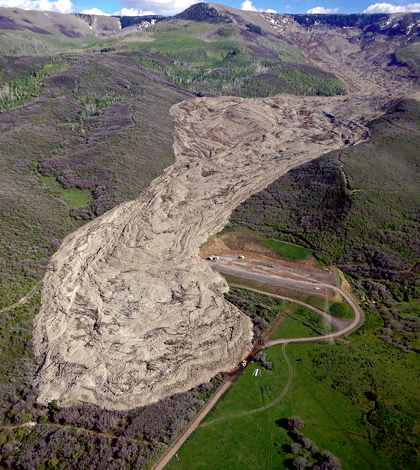Dry Landslides Move With Help Of Vibrations, Model Finds

A 1994 "long-runout" landslide in Mesa County, Colorado. (Credit: John White / Colorado Geological Survey)
The mechanisms responsible for large landslides have been studied for decades, with relatively solid ideas for how slides spurred by heavy rainfalls get going and continue on their path. But understanding similar mechanisms responsible for the movements of dry landslides has been alluding scientists for just as long. Part of the reason why is because it’s impossible to replicate these massive slides in a lab.
Way back in 1979, Jay Melosh, now a professor in Purdue University’s Department of Earth, Atmospheric and Planetary Sciences, was looking for a way to describe how such dry slides can occur. Since they have been observed on the Moon, Melosh easily ruled out an idea that the slides were floating on a cushion of air.
“My approach didn’t come from landslides at all,” said Melosh. “It came from trying to understand craters on the moon, and the mechanics of rocks in motion.”
To explain that, he drew on some knowledge he had gained while working part-time at the Los Alamos National Laboratory, where there was plenty of data on the effects of nuclear test explosions on vibrations in the Earth. In addition, it was common knowledge in that area that fault slips could occur thanks to the vibrations, and so he began to consider that in refining a theory to explain how such large slides get going.
In the theory, Melosh put forth that landslides of sufficient size could generate vibrational waves that could propagate through rock debris and make it possible for the slides to move further than smaller ones because the vibrations could reduce the effects of friction. He called his idea “acoustic fluidization.”
At the time, it was a pretty complex idea to propose. But now, more than 35 years later, technology has caught up enough to prove that Melosh’s theory was right all along.
“It’s been a long, uphill fight to convince the landslide community that the physics solution could solve the equation,” said Melosh. “They’re familiar with the roles of fluids, but they’re not familiar with vibrations.”
In 1995, Charles Campbell, a professor of aerospace and mechanical engineering at University of Southern California, led an effort to model the dynamics at play in such large, dry landslides. All the observations made sense, but the computers of the time didn’t have the capabilities to go further. And so pinpointing the mechanisms responsible for the reduction in friction wasn’t possible.
“He shared his computer code with me and I had a grad student revive the computer code. We ran it on 2014 computers instead of 1995 computers,” said Melosh. “And indeed, what I had described was going on.” The student is Brandon Johnson, who is now an assistant professor in the Department of Earth, Environmental and Planetary Sciences at Brown University. Johnson is the first author on the study and a “leading light in this field,” says Melosh.
Melosh is glad that there’s finally a way to explain the vibration mechanisms at play in the landslides, and is hopeful that the finding can help in other areas, such as in improving understanding of earthquake processes or disaster response.
“Understanding these landslides gives us more insight into how friction processes work, more insight into how earthquakes work,” said Melosh. For example, some of the forces that are seen when earthquakes occur are still sometimes overestimated. The results could help to remove that uncertainty.
Full results of the work are published in the Journal of Geophysical Research: Earth Surface.
Top image: A 1994 “long-runout” landslide in Mesa County, Colorado. (Credit: John White / Colorado Geological Survey)




0 comments